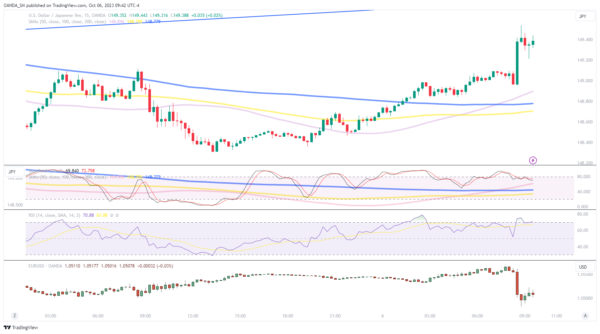- US jobs gains broadest since January; 336,000 created vs 170,000 eyed
- Wages unexpectedly came in cooler than expected; holding steady with a 0.2% monthly pace and on annual basis down from 4.3% to 4.2%.
- Dollar surges across the board with the exception to the Canadian dollar (Canada posted a robust 63,800 job gain themselves, tripling their consensus estimate).
The US economy is not ready to break. The September jobs report shocked Wall Street as 336,000 jobs were created, a strong enough of a number that could force the Fed to move again in November. This is a hot report as the headline job gains nearly doubled the consensus estimate and as the prior reading was revised 40,000 higher. This will be a peak for hiring as the job gains occurred in leisure and hospitality; government; health care; professional, scientific, and technical services; and social assistance.
Wages were slightly soft, but that is getting overlooked this time as 455,000 jobs were created when you include the two-month revision of 119,000.
Market reaction.
US stocks plunged after a hot jobs report sent Treasury yields soaring. Good news about the economy means corporate America is going to have to deal with higher interest rates for the rest of this year and probably most of 2024. Interest rate sensitive stocks and small companies are not going to do well with this current macro backdrop.
King dollar returned after job hiring hit the best pace since the start of the year. The Fed might get the all-clear signal to deliver one last rate hike if the October 12th CPI report shows disinflation struggles. Treasury yields are surging and higher-for-longer just got higher and longer. The spread between 2- and 10-year Treasury yield resteepened to the smallest inversion of the year. The yield curve isn’t quite ready to turn positive, but it sure is heading in the right direction.
Even if the Fed doesn’t deliver one more rate hike, the movement with Treasury yields will do the Fed’s tightening work for them. Yesterday, Fed’s Daly noted that with the rise in yields, the need to do additional tightening is not there. Today’s movement in yields bolsters her argument.
USD/JPY (euro) 15 minute chart
Labor Disruptions
The Kaiser Permanente workers entered a third day of strikes. The largest healthcare strike in history saw 75,000 workers walk off the job. The workers are demanding higher pay and additional benefits, which includes a 4-day work week.
United Auto Workers President Shawn Fain is expected to announce at 2pm if current negotiations have made enough progress that they won’t have to expand their strike. The gap was narrowed as it seems a 20% pay increase along with cost-of-living adjustments will get the automakers closer to the 30% wage gain sought over the life of the contract.
Once these strikes are over, wages will go up and undoubtedly other unions will seek to take advantage of the peak of this current economic cycle.













